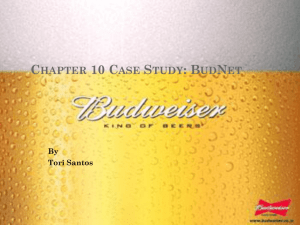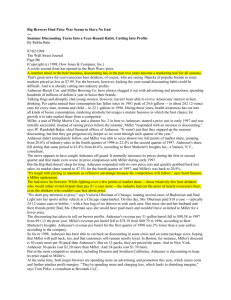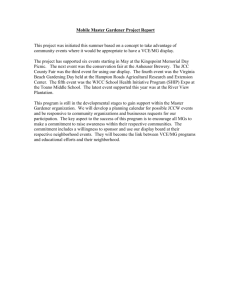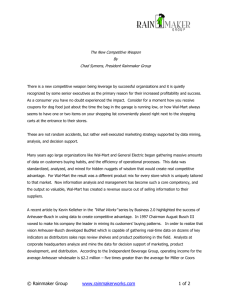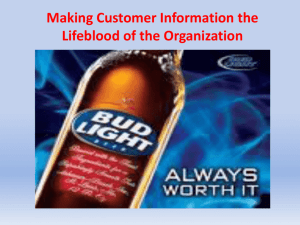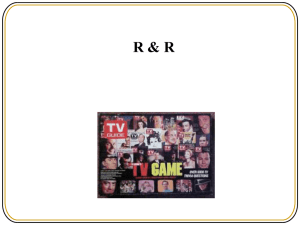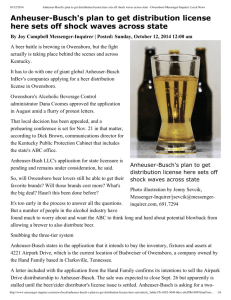BudNet
advertisement
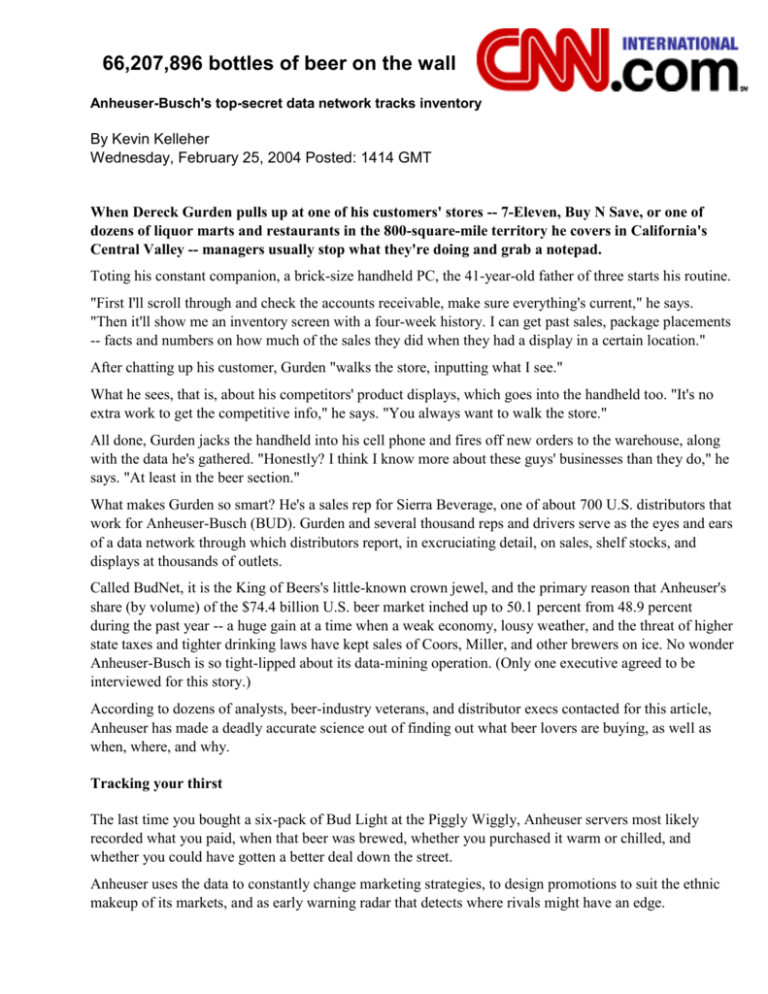
66,207,896 bottles of beer on the wall Anheuser-Busch's top-secret data network tracks inventory By Kevin Kelleher Wednesday, February 25, 2004 Posted: 1414 GMT When Dereck Gurden pulls up at one of his customers' stores -- 7-Eleven, Buy N Save, or one of dozens of liquor marts and restaurants in the 800-square-mile territory he covers in California's Central Valley -- managers usually stop what they're doing and grab a notepad. Toting his constant companion, a brick-size handheld PC, the 41-year-old father of three starts his routine. "First I'll scroll through and check the accounts receivable, make sure everything's current," he says. "Then it'll show me an inventory screen with a four-week history. I can get past sales, package placements -- facts and numbers on how much of the sales they did when they had a display in a certain location." After chatting up his customer, Gurden "walks the store, inputting what I see." What he sees, that is, about his competitors' product displays, which goes into the handheld too. "It's no extra work to get the competitive info," he says. "You always want to walk the store." All done, Gurden jacks the handheld into his cell phone and fires off new orders to the warehouse, along with the data he's gathered. "Honestly? I think I know more about these guys' businesses than they do," he says. "At least in the beer section." What makes Gurden so smart? He's a sales rep for Sierra Beverage, one of about 700 U.S. distributors that work for Anheuser-Busch (BUD). Gurden and several thousand reps and drivers serve as the eyes and ears of a data network through which distributors report, in excruciating detail, on sales, shelf stocks, and displays at thousands of outlets. Called BudNet, it is the King of Beers's little-known crown jewel, and the primary reason that Anheuser's share (by volume) of the $74.4 billion U.S. beer market inched up to 50.1 percent from 48.9 percent during the past year -- a huge gain at a time when a weak economy, lousy weather, and the threat of higher state taxes and tighter drinking laws have kept sales of Coors, Miller, and other brewers on ice. No wonder Anheuser-Busch is so tight-lipped about its data-mining operation. (Only one executive agreed to be interviewed for this story.) According to dozens of analysts, beer-industry veterans, and distributor execs contacted for this article, Anheuser has made a deadly accurate science out of finding out what beer lovers are buying, as well as when, where, and why. Tracking your thirst The last time you bought a six-pack of Bud Light at the Piggly Wiggly, Anheuser servers most likely recorded what you paid, when that beer was brewed, whether you purchased it warm or chilled, and whether you could have gotten a better deal down the street. Anheuser uses the data to constantly change marketing strategies, to design promotions to suit the ethnic makeup of its markets, and as early warning radar that detects where rivals might have an edge. "If Anheuser-Busch loses shelf space in a store in Clarksville, Tennessee, they know it right away," says Joe Thompson, president of Independent Beverage Group, a research and consulting firm. "They're better at this game than anyone, even Coca-Cola (KO)." As recently as six years ago, the beer industry was a technological laggard. Distributors and sales reps returned from their daily routes with stacks of invoices and sales orders, which they'd type into a PC and dial in to breweries. They, in turn, would compile them into monthly reports to see which brands were the hottest. But Anheuser changed the rules in 1997, when chairman August Busch III vowed to make his company a leader in mining its customers' buying patterns. Demanding to know While most brewers were experimenting with Internet-based record keeping, Anheuser began amending its contracts with wholesalers to demand that they start collecting data on how much shelf space their retailers devoted to all beer brands, which ones had the most visible displays, and the locations of those displays. At first, it was left up to the distributors to figure out just how to amass the data and deliver reports to Anheuser; many resorted to sending in Excel spreadsheets, a method that grew cumbersome as Anheuser demanded more data. A cottage industry quickly emerged for software developers who, working with Anheuser execs, simplified the process for distributors. It then fell to Joe Patti, Anheuser's vice president for retail planning and category management, to fine-tune the system into BudNet. "Wholesaler and store-level data has become the lifeblood of our organization," Patti writes in an e-mailed statement. Understatement is more like it: Collecting the data in a nightly nationwide sweep of its distributors' servers, Anheuser can draw a picture each morning of what brands are selling in which packages using which medley of displays, discounts, and promotions. Anheuser then sends its distributors out with new marching orders. "Since Michelob Light [an Anheuser brand] serves as an official sponsor of the LPGA Tour," Patti explains, "if someone asks how the brand is distributed on golf courses, we can quickly calculate our distribution and develop plans to address the courses that don't carry Michelob Light." That's an advantage Anheuser enjoys for two reasons. First, the company wields Wal-Mart-like clout with wholesalers and insists on exclusive deals with as many as possible, offering incentives for those that comply, IBG's Thompson says. Second, none of the other brewers approaches Anheuser's data-mining savvy. "It's not just collecting data," says Harry Schuhmacher, editor of Beer Business Daily. "It depends on brainpower. Anheuser-Busch is the smartest in figuring out how to use it." Driven by the numbers The trick has served Anheuser beautifully since Busch III announced the company's tech blitz. Anheuser has posted double-digit profit gains for 20 straight quarters, while its nearest competitors, Coors and Miller, have flatlined. Today it's the only major brewer to rely heavily on data from Information Resources Inc. -- which tracks every bar-coded product swiped at checkout and performs Nielsen-style consumer surveys -- and to conduct its own monthly surveys to see what beer drinkers buy and why. Parsing the aggregate data tells Anheuser what images or ideas to push in its ads, and what new products to unveil -- such as low-carb Michelob Ultra, Anheuser's most successful launch since Bud Light. This data, crossed with U.S. Census figures on the ethnic and economic makeup of neighborhoods, also helps Anheuser tailor marketing campaigns with a local precision only dreamed of a few years ago. The data reveals trends by city (Tequiza may be hot in San Antonio, but Bud Light plays better in Peoria), by neighborhood (gay models appear on posters in San Francisco's Castro district, but not on those in the Mission), by holiday (the Fourth of July is a big seller in Atlanta, but St. Patrick's Day isn't), and by class (cans for blue-collar stores, bottles for white-collar). "They're drilling down to the level of the individual store," Thompson says. "They can pinpoint if customers are gay, Latino, 30-year-old, college-educated conservatives." Anheuser's most sought-after demographics? Twenty-somethings and Latinos. Not only are both more likely to drink beer than the overall population, but these groups are also projected to grow by more than 3 percent a year through 2010, according to Census Bureau estimates. Gaining strength BudNet hasn't just added efficiency into the beer chain, it's changed the dynamics of the industry. The data juggernaut has turned the beer wholesaling business from an unruly network of mom-and-pops into an industry in which only the most tech-savvy survive. (Three of the six biggest distributors in the country -Ben E. Keith Beers, Silver Eagle Distribution, and Hensley & Co. -- handle only Anheuser suds.) According to the Independent Beverage Group, operating income for the average Anheuser wholesaler is $2.2 million -- five times greater than the average for Miller or Coors distributors. And wholesalers that don't perform to Anheuser's ever stricter standards are unceremoniously dumped. One distributor, founded by former Yankees slugger Roger Maris after his 1968 retirement, sued Anheuser in 1997, winning $50 million in damages after arguing that the beer company unfairly cut it loose. "Anheuser-Busch keeps their distributors under its thumb," says Madison McClellan, an attorney for Maris Distributing. The case is under appeal, but Anheuser shows no signs of letting up. At a recent gathering of beer distributors, August Busch IV, president for domestic operations, promised his audience that "brewers and wholesalers with a clear data-driven focus will have a distinct competitive advantage." According to Bal Maraj, president of MIT Systems, which makes software for devices used by several Anheuser distributors, the company will soon require all of its drivers and sales reps to carry handheld computers for wireless data uploads, just as Gurden does. Three years ago, still toting around clipboards and invoices, Gurden didn't even bother keeping track of the Coors and Miller displays in his customers' stores. Today those are among the most important data fields in his handheld. And Coors and Miller are paying dearly for what he knows.

